Terrarium Plants
Terrarium plants provide practical demonstrations of closed ecological systems, showcasing the balance of water cycles, light, and plant physiology within a controlled environment.
These self-sustaining ecosystems are designed to minimize maintenance and maximize indoor plants’ aesthetic and health benefits.
In a terrarium, the glass enclosure creates a unique microclimate. Sunlight passing through the glass heats the air and surfaces inside during the day, causing moisture from the soil and plants to evaporate. This water vapor then condenses on the cooler glass walls and eventually drips back to the soil, demonstrating a miniature version of the Earth’s water cycle.
Scientifically, this setup is ideal for studying transpiration, photosynthesis, and condensation. Each plant selected for a terrarium plays a role in maintaining the balance of humidity and air purity, making choices critical. For example, small ferns and mosses thrive in high humidity and low light, efficiently cycling moisture and oxygen. Succulents, on the other hand, are suited for drier terrariums with bright light, where they help regulate moisture levels without the risk of mold growth.
The design of a terrarium also needs to consider plant growth patterns and space utilization. Compact plants that grow slowly are preferable to prevent overcrowding and reduce maintenance like pruning.
Overall, terrariums are not just decorative items; they are living systems that can be used to study and demonstrate ecological principles in a compact, manageable way. They can serve educational purposes or simply enhance indoor air quality and personal well-being by bringing a piece of nature into indoor spaces.
- April 25, 2024
- Dagmara Mach
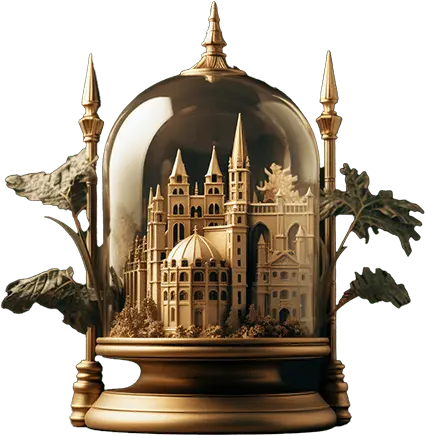
African violets (Saintpaulia species)
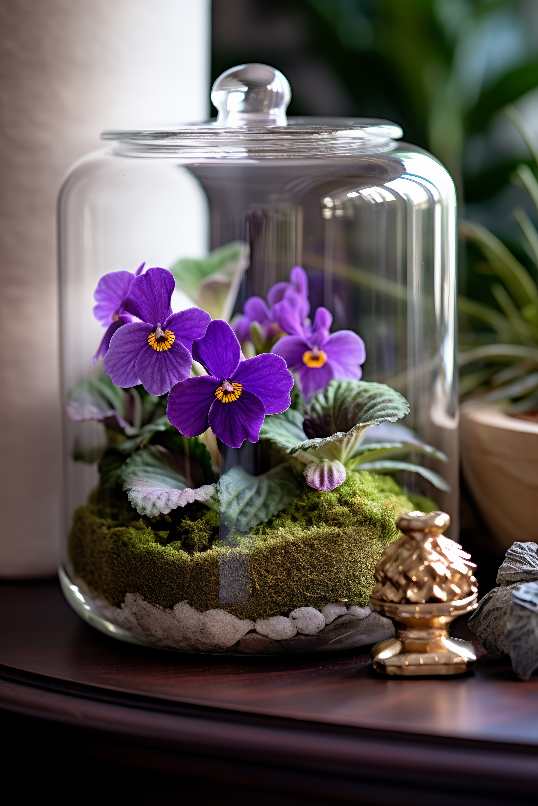
African violets (Saintpaulia species) make popular choices for terrariums, particularly when paired with moss because they thrive in the humid, controlled environment that terrariums provide. This setup mimics the understory habitat where African violets naturally grow, offering an ideal balance of humidity, soil moisture, and indirect light.
Ideal African Violet Growing Conditions
- Soil and Watering: Use a light, porous soil mix designed for African violets, which typically includes peat moss, perlite, and vermiculite. This ensures good drainage and air circulation to the roots. Watering should be minimal; the enclosed terrarium and the moss help retain sufficient moisture. It’s crucial to avoid waterlogging, which can lead to root rot. Water at the base to keep the leaves dry and prevent leaf spot diseases.
- Temperature: Maintain a consistent temperature, ideally between 65°F and 75°F (18°C to 24°C). African violets are sensitive to cold drafts and extreme temperature fluctuations, which can be mitigated in the stable environment of a terrarium.
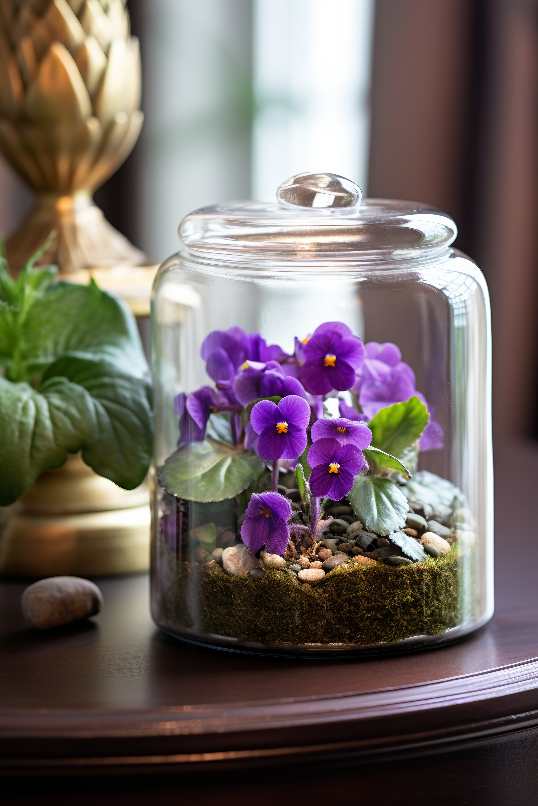
Forget-me-nots (Myosotis spp.)
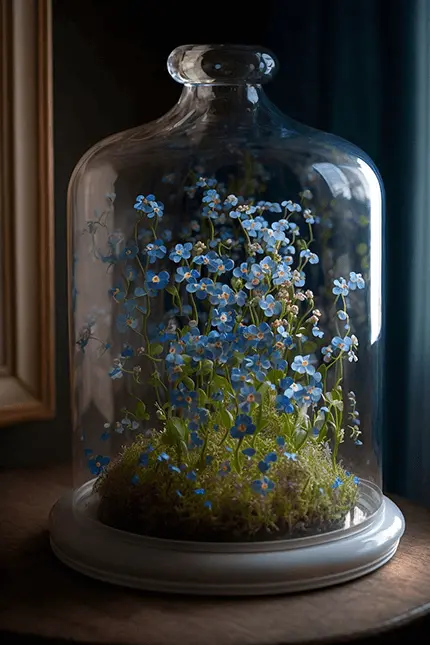
Forget-me-nots (Myosotis spp.) are charming, small-flowered plants that can bring a splash of delicate blue to a terrarium. They thrive in cool, moist conditions, making them suitable for closed terrariums that simulate a moist, woodland environment. Here’s how to successfully cultivate forget-me-nots in a terrarium setting, particularly when incorporating moss, which shares similar environmental needs:
Ideal Forget Me Not Growing Conditions
Lighting: Forget-me-nots prefer bright, indirect light. Direct sunlight can be too harsh, causing the leaves to scorch, so a location near a window with filtered light or under artificial grow lights is ideal.
Humidity: These plants thrive in high humidity, which makes them perfect for a closed terrarium. The enclosed space helps maintain the moist air they love.
Soil and Watering: Use a well-draining but moisture-retentive soil mix. Peat moss mixed with perlite or vermiculite is a good choice as it holds moisture without becoming waterlogged. Watering should be done carefully to maintain moist soil, but it’s crucial to avoid water stagnation to prevent root rot.
Temperature: Forget-me-nots do well in cooler temperatures, typically preferring conditions between 60°F and 70°F (15°C to 21°C). They are not tolerant of high heat, which makes them suitable for temperate climates or air-conditioned indoor environments.
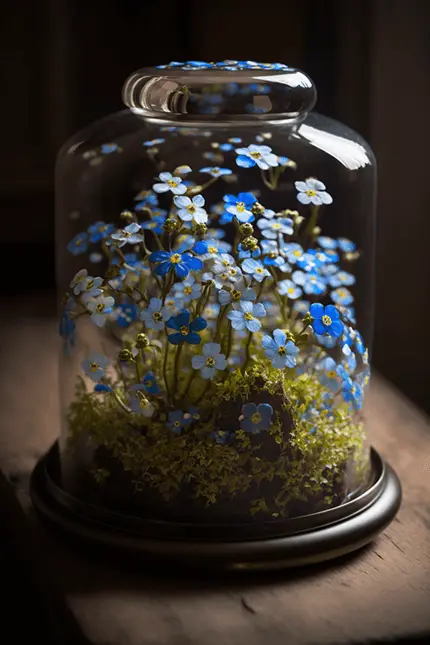
Johnny jump-ups (Viola tricolor)
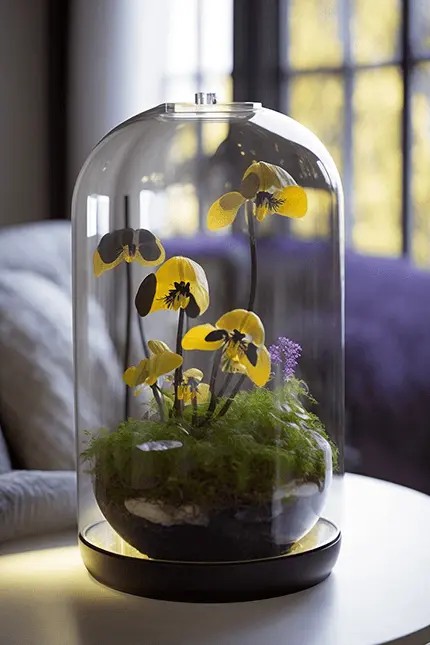
Johnny jump-ups (Viola tricolor), also known as wild pansies, are delightful small flowers that can brighten up a terrarium with their vibrant colors and charming appearance. They are well-suited to terrarium environments that mimic their natural, somewhat moist and shaded habitat. Here’s how to successfully integrate Johnny jump-ups into a terrarium setting, especially when including moss, which has complementary care needs.
Ideal Johnny Jump Up Growing Conditions
Lighting: Jade plants require plenty of bright, indirect sunlight to thrive. They are best positioned near a window that receives several hours of light but should be protected from intense direct sunlight, which can scorch their leaves.
Humidity and Ventilation: Unlike typical terrarium setups that favor high humidity, jade plants need a more arid environment with good air circulation to prevent moisture-related issues like rot. It’s advisable to use a terrarium with a vent or open top to allow excess moisture to escape.
- Soil and Watering: Use a well-draining cactus or succulent mix to ensure that water does not sit around the roots. Water sparingly, allowing the soil to dry out completely between waterings. The presence of moss can complicate this, as moss needs to stay relatively moist to survive. It’s crucial to strike a balance where the moss is lightly misted without saturating the soil around the jade plant.
- Temperature: Jade plants prefer warmer temperatures, ideally between 65°F and 75°F (18°C to 24°C). They should be protected from extreme temperature swings and cold drafts.

Jade plants (Crassula ovata)
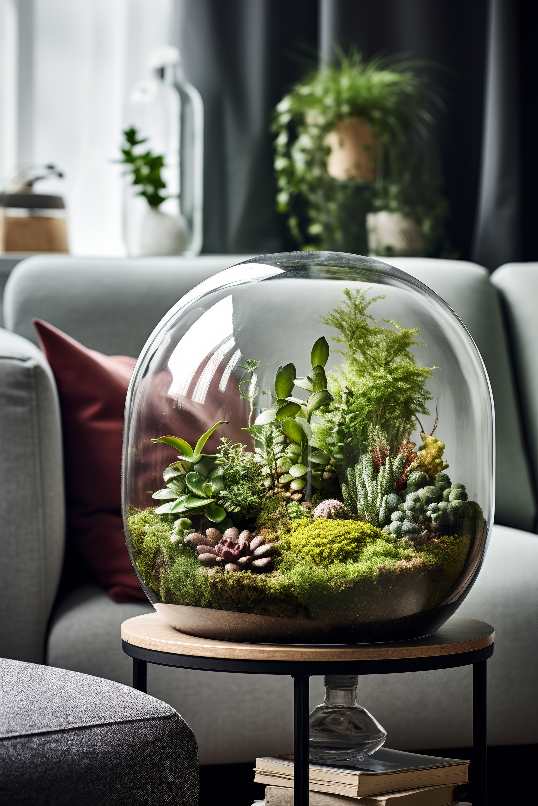
Jade plants (Crassula ovata), also known as lucky plants or money trees, are succulent plants that can be included in terrariums, particularly those designed to have drier conditions compared to those suited for tropical plants like African violets. When paired with moss, special considerations must be made due to the differing moisture needs of the two. Here’s how you can successfully integrate jade plants and moss in a terrarium setting:
Ideal Jade Growing Conditions
Lighting: Jade plants require plenty of bright, indirect sunlight to thrive. They are best positioned near a window that receives several hours of light but should be protected from intense direct sunlight, which can scorch their leaves.
Humidity and Ventilation: Unlike typical terrarium setups that favor high humidity, jade plants need a more arid environment with good air circulation to prevent moisture-related issues like rot. It’s advisable to use a terrarium with a vent or open top to allow excess moisture to escape.
- Soil and Watering: Use a well-draining cactus or succulent mix to ensure that water does not sit around the roots. Water sparingly, allowing the soil to dry out completely between waterings. The presence of moss can complicate this, as moss needs to stay relatively moist to survive. It’s crucial to strike a balance where the moss is lightly misted without saturating the soil around the jade plant.
- Temperature: Jade plants prefer warmer temperatures, ideally between 65°F and 75°F (18°C to 24°C). They should be protected from extreme temperature swings and cold drafts.

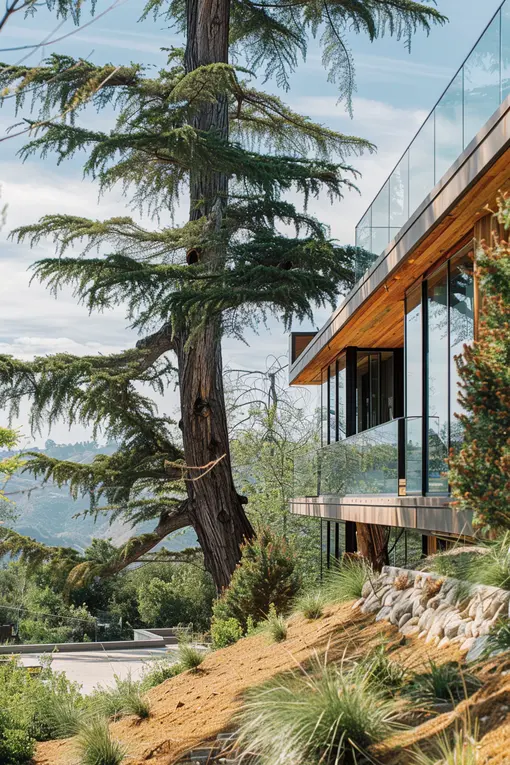
These grasses, shrubs, and trees stabilize soil, reduce runoff, and improve infiltration through deep and extensive root systems. Learn more.
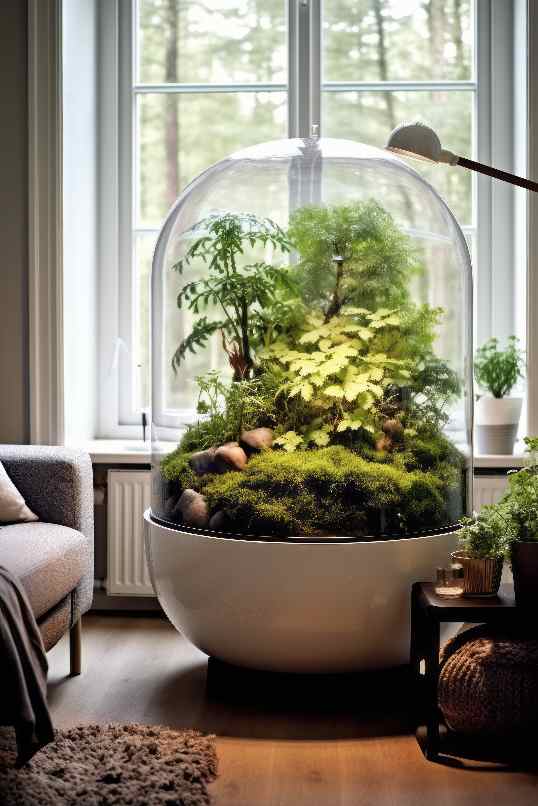
Low maintenance microclimates for indoor plants. Learn more.
